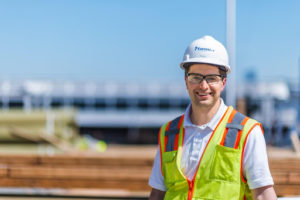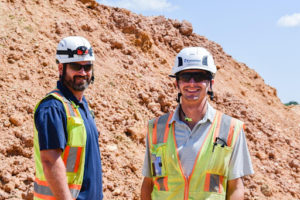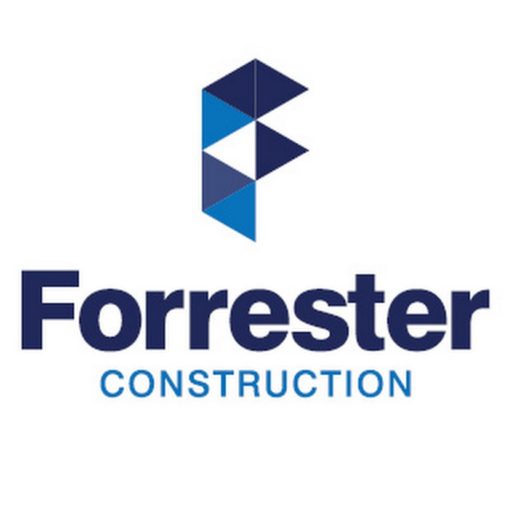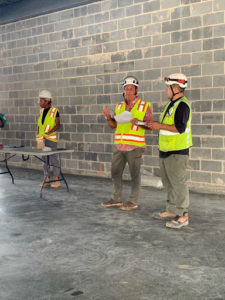Are you looking for construction safety tips? Construction safety is essential! Whether you are a new construction professional or have worked in the construction industry for years, it is important to review safety rules, protocols, and tips and ensure you follow all guidelines. Many safety programs and policies are in place because of government laws and regulations, such as the Occupational Safety and Health Administration (OSHA) standards. OSHA standards set a baseline for safe practices on jobsites, but companies often have additional rules in their safety policies. Government-mandated and company-specific safety practices will help you avoid serious workplace injuries and stay safe on jobsites. These important construction safety tips explore how construction professionals keep safety a top priority!
Always Wear the Right PPE

Personal protective equipment, or PPE, covers everything from your hard hat to your steel-toed boots. In construction, most PPE must meet American National Standards Institute (ANSI) standards. There are several categories of PPE:
- Eyes and Face
- Head Protection
- Foot and Leg Protection
- Hand and Arm Protection
- Body Protection
- Hearing Protection
The OSHA PPE guide has additional information and examples of PPE in each category. Some types of personal protective equipment are only worn when performing specific tasks, such as welding shields or leather gloves. Other PPE, like hard hats, steel-toed boots, and safety vests, are always required on job sites. Your employer should provide specific equipment for you, such as safety glasses or hard hats, and should train you on the proper use of PPE. Employers should also regularly review, update, and evaluate the effectiveness of their PPE inventory and PPE programs. If you start at a construction company, your employer should notify you of any additional PPE you need to supply yourself. Personal protective equipment you may have to supply yourself could include steel-toed boots or everyday clothing. Make sure all of your PPE is in good condition and fits you properly, to ensure the highest level of protection.
Implement Ongoing Safety Trainings
Every employee working on a construction job site should complete an extensive safety orientation before starting on site. Construction safety orientations should cover your company safety policy, project-specific safety plans, and more. If you need a template for creating your construction orientation presentation, the Associated Builders and Contractors (ABC) has you covered! Upon starting a job at a construction company, many employers, like Forrester Construction, also require their operations team members to complete a 10 hour or 30 hour OSHA Safety Training.
No matter how long an employee has been in the construction industry, construction professionals should participate in regular safety meetings and trainings. These safety trainings can outline any updates to safety protocols, give a refresher on existing procedures, highlight construction safety tips, or provide any clarification when needed. OSHA offers many construction safety courses in their online library on various topics such as confined spaces, cranes and rigging, electrical safety, and much more.
At Forrester Construction, our teams have regular toolbox talks and all-hands safety meetings that feature relevant safety topics during the construction progress. For example, in the summertime, our teams have All Hands Meetings on Preventing Heat-Related Illness with all on-site subcontractor partners in attendance.
Ensuring your team members and those working on your site are familiar with safety protocols helps your team know what to do should any issues arise.
Maintain An Emergency Response Plan
Having an up-to-date emergency response plan is vital in keeping yourself and all those on your job site safe. Emergency response plans explain what steps team members should take in case of an emergency to ensure team member safety and mitigate any disturbance to day-to-day operations. Your company’s plan may include directions to the nearest hospital, emergency contact information, how to respond to workplace injuries, what to do if a structure becomes unstable, and more. Having a detailed and clear emergency response plan is critical in making sure employees know what to do if an emergency arises on a construction site.
Respect and Maintain Your Equipment
On each jobsite, there should be a designated place to store tools and other equipment. Before using any piece of equipment:
- Familiarize yourself with its safe use. You should know how to check to ensure it is operating correctly and in good condition.
- Clean and care for the equipment before returning it to its designated storage place.
- Make sure you are wearing the proper PPE.
- Tell your supervisor that you need training if you don’t know how to use something.
While respecting your tools and equipment is essential, another crucial step to keeping a construction site safe is to properly maintain your equipment. Every piece of equipment should be inspected regularly to ensure that it functions correctly and that there are no significant issues. If you find a piece of equipment that could potentially cause issues, it is important to remove it from use until it is fixed and deemed safe.
Follow Instructions
Jobsite instructions and rules come in many forms, most of which are in place to help you stay safe on a construction site. Some instructions come in the form of signs and other written notices hung on site. Stay alert on every job site and pay attention to every sign you see. Other directions or rules might be given verbally, over email, or during a safety meeting or training. Regardless of how instructions are delivered, be mindful of them and follow all rules on site to keep yourself and your fellow workers safe.
Don’t Be Afraid to Ask for Help
It is important for employees to be comfortable with asking for help when needed. To help ensure this happens, make sure your team is flexible and understanding about any situations they may encounter. Employees who feel comfortable approaching leadership will be more likely to disclose if they are struggling with a responsibility that could impact the overall construction site.
If you have questions about any safety rules, talk to your manager or your company’s leadership. They can either answer your questions directly or help you find the answers from a trustworthy source. When you take the time to understand your company’s safety regulations, you face a lower risk of suffering accidents that might otherwise lead to missed days from work, or worse.
Join a Safety Group or Industry Association
If you need advice, tips, or are looking to collaborate with other construction professionals on improving your company’s safety program, joining an industry association or safety group could be a great resource. Many industry associations, such as the local chapters of Associated Builders and Contractors (ABC), have safety committees that could give great insight into how other companies keep their team members safe. One partnership that has been beneficial to Forrester Construction has been the Maryland SPECS Program (Strategic Partnership for Excellence in Construction Safety). As one of the founding members and the first General Contractor to reach level two in the program. this partnership has allowed Forrester to collaborate, assess, and discuss safety practices with other contractors in our area who have the same commitment to safety as our company.
Conclusion
Whether you are a company leader, an employee for a general contractor, or a subcontractor partner working on site, safety is one of the most important aspects of working in construction. Using PPE, implementing ongoing training, using equipment properly, and continually assessing your safety program are vital in making sure that all team members go home from their site safely every day.
Want to learn more about the construction industry? Read more of our blog posts.


